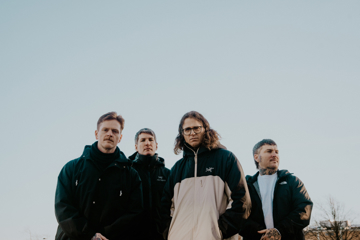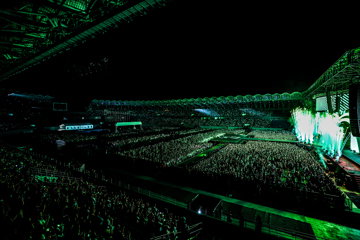From Big Days Out To Glamper Campers: How Festivals Have Changed In The 2010s
Liz Giuffre examines how the Australian festival circuit has evolved since 2010, from the mega-festival like Big Day Out to more boutique offerings, in the face of changing oversight from the government.
Over the last decade there’s been a marked change in the way we engage with live music. The glory days of, well, Big Days, were in full swing in 2010, but as we hurtle towards 2020, it seems they are gone.
Over the last decade things have changed, but that’s not to say that audiences and tunes don’t still hook up. Instead, we’ve found different ways of doing it – yes, with quite a bit of ‘swiping’ involved – but also moving from massive roadshows to location-based mini-breaks.
The carnival is over – or just different
The big one, the Big Day Out, made it into the 2010s on life support, but officially gave up the ghost in 2014. Local showcase Homebake had died just a little before this in 2012 (with the last featuring that iconic ‘homegrown’ act, Blondie). Big electronic festivals Future Music and Stereosonic both wound up in 2015. Wonderful blips in between like All Tomorrow's Parties have come and gone, while Groovin The Moo has continued to evolve. While official statements about the decline of these festivals have varied, it’s been suggested the cost of putting them on was simply getting too much and audiences were wanting something different. A recent Double J podcast revisited the Big Day Out's glory days, as well as speculating about its end.
The festivals that have continued combine music with an experience – often a trip away – so that the audience, as well as artists, can ‘go on tour’. Case in point is Splendour In The Grass and Falls Festival, each events that have become an excuse for punters to get their road trip and camp trip on as much as a draw to see and hear music, like Schoolies (or say Tune-ies?) for grown-ups. But they're also the type of thing that only very few can experience, while the rest of us, broken by scalpers, cost and logistics, live vicariously through media reports and live broadcasts.
One example of a new type of festival experience is Lost Paradise, held over New Year's in Glenworth Valley, NSW, which offers access to Tent City or to “Glamping” – the glam way to get yourself a muddied crick in the neck from sleeping on the ground. Jokes aside, with luxuries like electricity, a dedicated cocktail bar and "premium toilets and showers", even the messiest of rock pigs can see the appeal. Falls and lots of other events now offer similar options too – and while the cost is higher, it’s often worth saving up for.
Don't miss a beat with our FREE daily newsletter
The changing demographics of festival audiences (and artists)
While it’s hard to say definitively, one thing that’s certain is that the age target and type of festivals seems to have changed. All ages and older ages events like A Day On The Green, which calls itself "Big Day Out For Grown-ups", have allowed not just ‘heritage acts’, but also perhaps ‘heritage audiences’ to get out and party beyond the traditional stadiums, concert halls or lounge rooms. Then events like The Lost Lands Festival welcome families to participate – a move that seems to be increasing, and allows existing audiences to continue to participate as their circumstances change, while also getting the next generation into the festival vibe as early as possible.
A war waged by law and order
Changes to local, state and federal laws have been suggested as catalysts for festival change. In the case of small-scale local events like Mountain Sounds, organisers directly took aim at changes to legal requirements, or what they called “the government’s war on festivals”.
The increased legislation often relates to increased health and safety requirements for festival organisers. Yes, this stuff wasn’t as strict pre-2010, but pre-2010 was a time when patrons were being injured and, in still one of the saddest days for Australian music, killed in the crush.
These days increased legal requirements seem to relate to drug and alcohol as well as physical space and safety. From Sydney’s infamous lockout laws to state- and nationwide attempts to clean up the perceived marriage of sex, drugs and rock'n'roll, these moves have had varied success. Importantly, they’ve not necessarily changed behaviour or significantly reduced serious injury or death rates. A 2019 Australia-wide study of drug use at festivals, and specifically, the rates attendees seek help when they need it, shows that the biggest dangers still lie with punters’ lack of education about what is in the drugs they are thinking of, or have just, taken. Organisers of festivals that have trialled onsite drug testing have already estimated lives saved, but official government policies around the country seem to remain dead against the practice.
Beyond the law, the question of how to behave at festivals (and importantly, how festival-goers should treat each other) is one that organisers now are taking seriously. For example, Meredith has a strict “No Dickhead Policy”, a no-nonsense approach that says the festival should be a safe space for all attendees. While such a thing should go without saying, it is nice to hear it said. This includes not just physical safety, but also basic levels of respect towards others. Keep your hands to yourself, unless invited to do otherwise.
It’s not all doom and gloom – these festivals are roaring into the 2020s
While we’ve lost some big names in the last decade, the festival circuit has still thrived. In addition to stayers like Bluesfest, Splendour In The Grass, Laneway and Groovin The Moo, there’s also city-based festivals (and their fringe events) like Sydney Festival, Adelaide Festival, Melbourne Festival, Brisbane Festival, Darwin Festival – and on it goes. Then there are the REALLY BIG stayers like Tamworth, Field Day, Melbourne Jazz Festival, Woodford Folk Festival, alongside diverse genre and destination events like FOMO, Golden Plains, Pitch, Subsonic, Beyond The Valley, Strawberry Fields, Rainbow Serpent and Fairgrounds.
So no excuses – get yourself out among it. Even if it’s more than one big day out.







